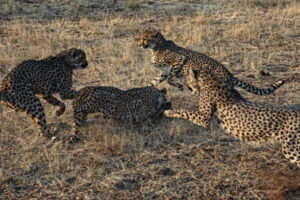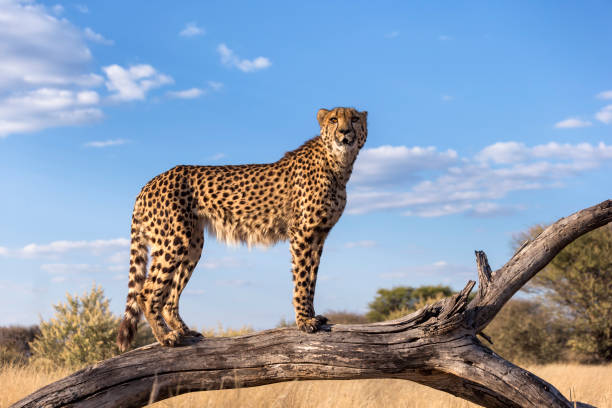In India, how are cheetahs doing?

- Cheetah deaths were recently reported from Madhya Pradesh’s Kuno National Park (KNP) last week. An expert group overseeing the Project Cheetah initiative has advised that all animals receive a comprehensive medical examination.
Project Cheetah:
- The relocation initiative for cheetahs in India is called Project Cheetah, and it is arguably one of the most ambitious in the world. The plan is to introduce 5–10 animals yearly for the following ten years until a population of 35 cheetahs that can support itself is created.
- India’s objective is to allow cheetahs to develop in their natural, untamed habitats, as opposed to the enclosed areas where they now reside in South Africa and Namibia.
- 11 of the translocated cheetahs are currently living in the wild, with four of them housed in ‘bomas,’ specifically made cages that are one square kilometer in size and are used to assist the animals acclimate to the circumstances in India.
- Three of the four cubs born in India and five of the translocated animals have perished.
The requirement for medical review
- Surya, one of the cheetahs, was discovered dead in KNP last week.
- When veterinarians examined the animal, they discovered a neck wound that was infected with maggots.
- The radio-collar that was fastened around the cheetah’s neck also contained the maggots’ larvae.
- The cheetah might have become ill as a result of chafing from the collar. The polystyrene collars that cheetahs wear have a radio-frequency tracking chip that aids in keeping an eye on the animals.
- The cat may not have been able to lick itself clean, which would have caused parasites to fatally lodge inside the incision. This may have been compounded by the dampness from the monsoon season, to which South African cheetahs are not accustomed.
- There is also a theory that the African animal may have been exposed to parasites through the wound that Indian big cats are often immune to.
- In the absence of scientific proof, the Environment Ministry, in a note dated July 16, disregarded these claims as hearsay. The expert group has advised that all living animals get a complete physical checkup in order to evaluate these concerns.
Project Cheetah’s rate of success:
- It will have been a year since a group of eight cheetahs from Namibia arrived in India in September 2023. In February 2023, 12 more South Africans followed them. Independent critics have claimed that the project has certain fundamental problems despite being designed as an experiment that is prone to failure in the first few years.
- In February 2023, 12 more South Africans came after them. Independent critics have claimed that the project has certain fundamental problems despite being designed as an experiment that is prone to failure in the first few years.
- Having all 20 cheetahs in KNP is a mistake, as there is insufficient space and prey for the species, which is a courser and requires great distances.
- Additionally, the prolonged confinement of cheetahs has hampered their capacity for adaptation and exacerbated their psychological adjustment issues, increasing their susceptibility.
- Cheetahs are rather sensitive creatures and are more likely to sustain fatal injuries in the wild than tigers and leopards.
- Other comparable predators like lions and leopards do not currently pose a threat to Indian cheetahs. It will therefore take time to determine whether the animals can successfully colonize India.
Why Cheatha’s are Important for India?
In recent years, there have been discussions and efforts to reintroduce the cheetah to India. The reintroduction of the cheetah is important for several reasons:
- Biodiversity Conservation: Cheetahs are an important part of India’s biodiversity. Reintroducing them can help restore ecological balance and preserve the country’s natural heritage.
- Ecological Balance: As apex predators, cheetahs play a crucial role in regulating the populations of their prey species. Their presence can help control herbivore populations and maintain a healthy balance in the ecosystem.
- Ecotourism: Reintroducing cheetahs can boost ecotourism, attracting wildlife enthusiasts and tourists to visit India and contribute to the local economy.
- International Reputation: The successful reintroduction of an iconic species like the cheetah would enhance India’s reputation globally for its commitment to conservation and wildlife protection.
It is worth noting that cheetah reintroduction is a complex process that involves careful planning, habitat restoration, and monitoring. It requires support from various stakeholders, including conservation organizations, governments, and local communities. If the efforts are successful, the reintroduction of cheetahs could be a significant milestone for wildlife conservation in India. However, please note that developments or changes might have occurred since my last update, so I recommend checking more recent sources for the latest information on this topic.

- Speed: Cheetahs are the fastest land animals, capable of reaching speeds of up to 60 to 70 miles per hour (97 to 113 kilometers per hour) in short bursts. They can accelerate from 0 to 60 miles per hour in just a few seconds.
- Range and Habitat: Historically, cheetahs were found in various regions of Africa and parts of the Middle East and Asia. However, currently, they are mostly confined to sub-Saharan Africa. They inhabit a range of habitats, including grasslands, savannas, and open plains.
- Physical Characteristics: Cheetahs have a slender, long-legged body built for speed. Their coat is covered in distinctive black spots on a tan background, providing excellent camouflage in their natural environment. They also have tear marks running from their eyes down to their mouth, which help reduce glare from the sun and aid in hunting.
- Hunting Strategy: Cheetahs are carnivorous and primarily hunt small to medium-sized ungulates, such as gazelles and impalas. Their hunting strategy involves stalking their prey at a distance and then using their incredible speed to chase and catch it.
- Conservation Status: Cheetahs are listed as vulnerable on the International Union for Conservation of Nature (IUCN) Red List of Threatened Species. Their population has declined significantly due to habitat loss, human-wildlife conflict, and poaching. Conservation efforts are underway to protect and preserve cheetah populations.
- Social Behavior: Unlike many other big cats, cheetahs are relatively social animals. They can be found in small family groups, often consisting of a mother and her cubs. Male cheetahs sometimes form coalitions with unrelated males.
Moving forward:
- Despite claims from officials that there is sufficient room and food in the Kuno reserve, plans exist to create a second reserve in Gandhisagar, Madhya Pradesh, as well as a facility for cheetah rehabilitation.



